Content is from Kirkbride et al. 2006Kirkbride et al. 2006:
Kirkbride JH, Jr, Gunn CR, and Dallwitz MJ. 2006. Family guide for fruits and seeds, vers. 1.0. Accessed September 2020-January 2022. URL: https://nt.ars-grin.gov/seedsfruits/keys/frsdfam/index.cfm ., without modification.
Updates are forthcoming.
Fruits: Pistil(s) compound; 1; 1-pistillate; with carpels united. Fruit pericarpium; simple; berryberry:
an indehiscent, fleshy fruit with one or a few to many seeds. The flesh may be homogenous throughout. Or, if the outer part is hard, firm, or leathery, referred to as an hesperidium. Septa are present in some, and the seeds may be arillate or with a fleshy testa.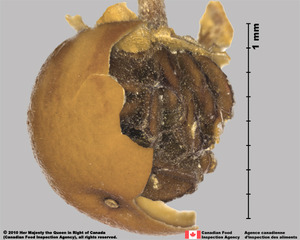 , or drupedrupe:
, or drupedrupe:
(indehiscent drupe) a fleshy, indehiscent fruit with one more hard pits enclosing seeds, derived from single, superior, simple or compound ovary; (dehiscent drupe) a fruit with a dry or fibrous to fleshy or leathery outer husk that early to tardily breaks apart (or opens), exposing one or more nutlike pits enclosing the seeds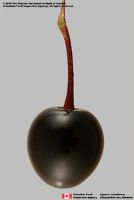 (Parathesis), or capsulecapsule:
(Parathesis), or capsulecapsule:
a dry, dehiscent fruit derived from a compound ovary (Aegiceras but not Spjut); fissuricidal capsulecapsule:
(Aegiceras but not Spjut); fissuricidal capsulecapsule:
a dry, dehiscent fruit derived from a compound ovary (Aegicera opening by 1 slit, but not in Spjut); capsulecapsule:
(Aegicera opening by 1 slit, but not in Spjut); capsulecapsule:
a dry, dehiscent fruit derived from a compound ovary not inflated; capsulecapsule:
not inflated; capsulecapsule:
a dry, dehiscent fruit derived from a compound ovary without operculumoperculum:
without operculumoperculum:
a dehiscent cap (or lid) of a seed or fruit that opens during germination or dehiscence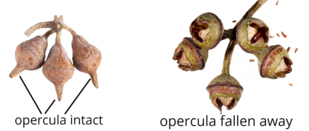 ; berryberry:
; berryberry:
an indehiscent, fleshy fruit with one or a few to many seeds. The flesh may be homogenous throughout. Or, if the outer part is hard, firm, or leathery, referred to as an hesperidium. Septa are present in some, and the seeds may be arillate or with a fleshy testa. indehiscent; berryberry:
indehiscent; berryberry:
an indehiscent, fleshy fruit with one or a few to many seeds. The flesh may be homogenous throughout. Or, if the outer part is hard, firm, or leathery, referred to as an hesperidium. Septa are present in some, and the seeds may be arillate or with a fleshy testa. without central placental mass, or with soft and juicy central placental mass easily separating from epicarpepicarp:
without central placental mass, or with soft and juicy central placental mass easily separating from epicarpepicarp:
outer layer of fruit wall or pericarp, if divided into layers; note here used synonymously with exocarp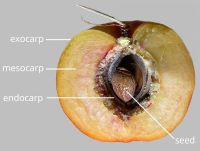 ; without persistent central column; not within accessory organ(s); Myrsinoiedeae 1-seeded to more than 1 but less than 10-seeded; 1-seeded (to several); with 3(–6)-carpellate (3–5(-6)); with carpels united; with carpels remaining united at maturity; with carpels not radiating at maturity; without sterilesterile:
; without persistent central column; not within accessory organ(s); Myrsinoiedeae 1-seeded to more than 1 but less than 10-seeded; 1-seeded (to several); with 3(–6)-carpellate (3–5(-6)); with carpels united; with carpels remaining united at maturity; with carpels not radiating at maturity; without sterilesterile:
lacking male and/or female reproductive parts; also, not producing fruit or seed
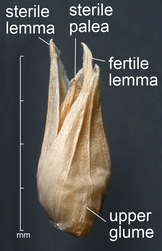 carpels; not sulcatesulcate:
carpels; not sulcatesulcate:
surface relief—having one or more elongate, relatively narrow and shallow depressions or grooves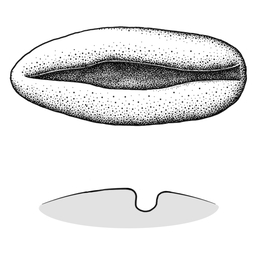 ; in transection tereteterete:
; in transection tereteterete:
approximately circular in cross section; width and thickness approximately equal
 ; apexapex:
; apexapex:
the point farthest from the point of attachment, or the "tip" of an organ not beaked; wall fleshy (for berryberry:
not beaked; wall fleshy (for berryberry:
an indehiscent, fleshy fruit with one or a few to many seeds. The flesh may be homogenous throughout. Or, if the outer part is hard, firm, or leathery, referred to as an hesperidium. Septa are present in some, and the seeds may be arillate or with a fleshy testa. ); indehiscentindehiscent:
); indehiscentindehiscent:
not opening on its own, as in a fruit
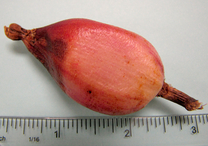 , or dehiscentdehiscent:
, or dehiscentdehiscent:
(v. dehisce) splitting open at maturity to release contents (of a fruit)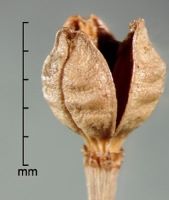 . Dehiscentdehiscent:
. Dehiscentdehiscent:
(v. dehisce) splitting open at maturity to release contents (of a fruit) unit seed(s). Dehiscentdehiscent:
unit seed(s). Dehiscentdehiscent:
(v. dehisce) splitting open at maturity to release contents (of a fruit) without replumreplum:
without replumreplum:
the rim, formed by the persistent placentas, and connected by a false septum in Brassicaceae fruits. The fruit valves are attached to this rim and separate from it in dehiscent fruits.
. Epicarpepicarp:
outer layer of fruit wall or pericarp, if divided into layers; note here used synonymously with exocarp purple, or black, or red; durable; glabrousglabrous:
purple, or black, or red; durable; glabrousglabrous:
without hairs
; without armature; smooth, or not smooth; resinous and punctatepunctate:
surface relief—dotted with pits or with translucent, sunken glands or with colored dots, similar to pitted (Parathesis tetramera Bullock); without wing(s); without apicalapical:
(Parathesis tetramera Bullock); without wing(s); without apicalapical:
at or pertaining to the end of the seed or fruit distal from its point of attachment (i.e., base)
respiratory hole. Mesocarpmesocarp:
the middle layer of the pericarp, if divided into layers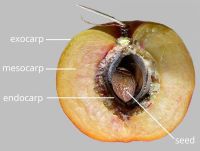 present; fleshy; composed of 1 unified layer; without lactiform cavity system; & endocarpendocarp:
present; fleshy; composed of 1 unified layer; without lactiform cavity system; & endocarpendocarp:
the inner layer of the pericarp, if divided into layers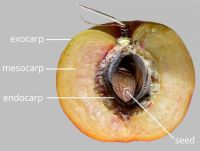 sharply differentiated. Endocarpendocarp:
sharply differentiated. Endocarpendocarp:
the inner layer of the pericarp, if divided into layers present, or absent; not separating from exocarpexocarp:
present, or absent; not separating from exocarpexocarp:
outer layer of fruit wall or pericarp, if divided into layers; note here used synonymously with epicarp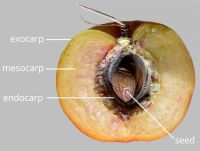 ; bonybony:
; bonybony:
very hard and rather brittle, like bone
, or thin; not splitting into 1-seeded pyrenes; without operculumoperculum:
a dehiscent cap (or lid) of a seed or fruit that opens during germination or dehiscence ; without secretory cavities; without longitudinallongitudinal:
; without secretory cavities; without longitudinallongitudinal:
of or relating to length or the lengthwise dimension
ridges. Funiculusfuniculus:
(alt. funicle) stalk connecting the ovule (later seed) to the ovary (later fruit) placenta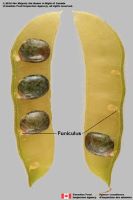 short; short without seed bearing hookswith hooks:
short; short without seed bearing hookswith hooks:
bristles or spines with curved or backwards pointing tips, or with secondary bristles along their length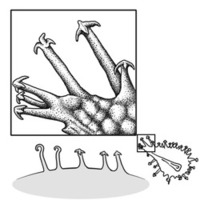 (retinacula); not persisting in fruit after seed shed.
(retinacula); not persisting in fruit after seed shed.
Seeds: Arilaril:
(broad sense) appendicular structure that wholly or partly envelops a seed and is produced from or a modification of the funicle, raphe, or outer integument; usually fleshy or pulpy, sometimes spongy or tufted-capillate, often brightly colored absent. Seed larger than minute; not bowl shaped; not nutlike; without winglike beakbeak:
absent. Seed larger than minute; not bowl shaped; not nutlike; without winglike beakbeak:
a usually firm, terminal appendage, sometimes tapered ; without caudatecaudate:
; without caudatecaudate:
tapering to a long, tail-like appendage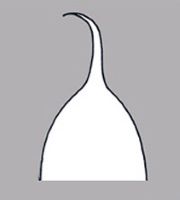 appendage(s); at maturity with food reserves, or without apparent food reserves; with endosperm; without canavanine. Sarcotestasarcotesta:
appendage(s); at maturity with food reserves, or without apparent food reserves; with endosperm; without canavanine. Sarcotestasarcotesta:
pulpy or fleshy outer layer of the seed coat, simulates aril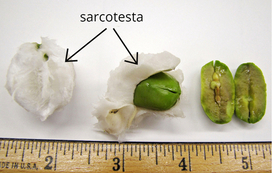 absent. Testatesta:
absent. Testatesta:
seed coat
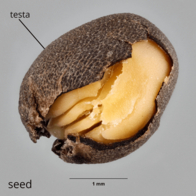 present, or absent; vestigial; without embryo surrounded and capped by viscid tissue; without markedly different marginalmarginal:
present, or absent; vestigial; without embryo surrounded and capped by viscid tissue; without markedly different marginalmarginal:
at, on, or close to the margin or border
tissue; without fleshy or leatheryleathery:
texture—moderately thick, tough, and very pliable
layer over hard layer; loose; surface unsmooth; surface with merged raised features; surface ribbedribbed:
surface relief—wide, prominent, linear ridges that are generally rounded and longitudinally situated on the surface , or striatestriate:
, or striatestriate:
surface relief—having fine, parallel lines, grooves or ridges ; without crease or line separating cotyledons from hypocotyl-radicle; without notch along margin where cotyledons from hypocotyl-radicle tip approach each other; without glands; without bristles; glabrousglabrous:
; without crease or line separating cotyledons from hypocotyl-radicle; without notch along margin where cotyledons from hypocotyl-radicle tip approach each other; without glands; without bristles; glabrousglabrous:
without hairs
; without wings; without collar; without operculumoperculum:
a dehiscent cap (or lid) of a seed or fruit that opens during germination or dehiscence ; colored; monochrome; black, or brown (all shades); thin; becoming mucilaginousmucilaginous:
; colored; monochrome; black, or brown (all shades); thin; becoming mucilaginousmucilaginous:
resembling mucilage; moist and sticky
when wetted, or not becoming mucilaginousmucilaginous:
resembling mucilage; moist and sticky
when wetted; surrounding food reserve. Endosperm development nuclear; copious, or trace (latter 2 for larger seeds of Aegiceras); hard, or fleshy; semi- transparent; smooth, or ruminateruminate:
testa or seed coat folded into the endosperm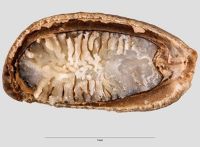 ; with starch; with oils; without fatty acid containing cyclopropene; without apicalapical:
; with starch; with oils; without fatty acid containing cyclopropene; without apicalapical:
at or pertaining to the end of the seed or fruit distal from its point of attachment (i.e., base)
lobes; without chlorophyll; without isodiametric faceted surface; without odor. Embryo differentiated from food reserve; well developed; 1 per seed (to many Ardisia); completely filling testatesta:
seed coat
 (no food reserve), or partially filling testatesta:
(no food reserve), or partially filling testatesta:
seed coat
 (with food reserve), or nearly filling testatesta:
(with food reserve), or nearly filling testatesta:
seed coat
 (trace or scanty food reserve); 0.6–1 times the length of food reserve; at one end of seed not extending into a depression or cup; axileaxile:
(trace or scanty food reserve); 0.6–1 times the length of food reserve; at one end of seed not extending into a depression or cup; axileaxile:
on or of the axis
and centric (when endosperm present); linearlinear:
(shape) long, narrow, and uniform in width; (of embryo) embryo is straight and much longer than wide ; straight, or bentbent:
; straight, or bentbent:
(of embryo) embryo is bent at an acute, V-shaped angle with the ends close together and generally thick cotyledons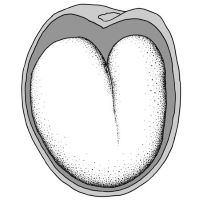 , or C-shapedC-shaped:
, or C-shapedC-shaped:
2D-shape—semiannulate, curved into the shape of the letter 'C'
; multiseeded fruits parallel to seed length, or transversetransverse:
lying, situated, or placed across
to seed length (single-seeded fruits); embedded in endosperm; with cotyledons gradually connected to hypocotyl-radicle; without coleorhiza; without simmondsin; without stomata; not green; with 2 or more cotyledons. Cotyledons 2; moderately developed; 0.2–0.3 times length of embryo; as wide as hypocotyl-radicle (more or less); 1 times wider than hypocotyl-radicle; not concealing hypocotyl-radicle; not foliaceous; thin; flat; smooth; with apicesapex:
the point farthest from the point of attachment, or the "tip" of an organ entire; with margins separate, or connate (Aegiceras); basally entire; equal in size; not punctatepunctate:
entire; with margins separate, or connate (Aegiceras); basally entire; equal in size; not punctatepunctate:
surface relief—dotted with pits or with translucent, sunken glands or with colored dots, similar to pitted dotted. Hypocotyl-radicle well developed; straight, or curvedcurved:
dotted. Hypocotyl-radicle well developed; straight, or curvedcurved:
(of embryo) linear embryo is curved into an arch or horseshoe with the ends far apart ; not thickened.
; not thickened.
Noxious weeds: 1 or more USA state noxious weeds in this family.
USA states and territories with listed noxious weeds: Hawaii (HI) and Washington (WA).
USA state and territory noxious weeds:
Ardisia elliptica Thunb.: USA state noxious weed: HI●°.
Lysimachia vulgaris L.: USA state noxious weed: WAª●.
Symbols: ªaquatic weed; ●terrestrial weed; °weed in seed.
Last updated February 2006.
General references: Boerlage, J. G. 1897–1914. Icones Borgorienses, 4 vols. E.J. Brill, Leiden (plate numbers are in [ ]), Corner, E.J.H. 1976. The seeds of Dicots, esp. vol. 2. Cambridge University Press, New York, Cronquist, A. 1981. An integrated system of classification of flowering plants, 1,262 p. Columbia University Press, New York, Gaertner, J. 1788–1805. De fructibus et seminibus plantarum. The Author, Stuttgart, Goldberg, A. 1986 (dicots) & 1989 (monocots). Classification, evolution, and phylogeny of the familes of Dicotyledons. Smithsonian Contr. Bot. 58 for dicots (314 pp.) & 71 for monocots (74 pp.). [Goldberg's illustrations are reproduced from older publications and these should be consulted], Gunn, C.R., J.H. Wiersema, C.A. Ritchie, & J.H. Kirkbride, Jr. 1992 & amendments. Families and genera of Spermatophytes recognized by the Agricultural Research Service. Techn. Bull. U.S.D.A. 1796:1–500, Mabberley, D.J. 1987. The plant-book, 706 p. Cambridge University Press, Cambridge, Martin, A.C. 1946. The comparative internal morphology of seeds. Amer. Midl. Naturalist 36:513–660, and Spjut, R.W. 1994. A systematic treatment of fruit types. Mem. New York Bot. Gard. 70:1–182.